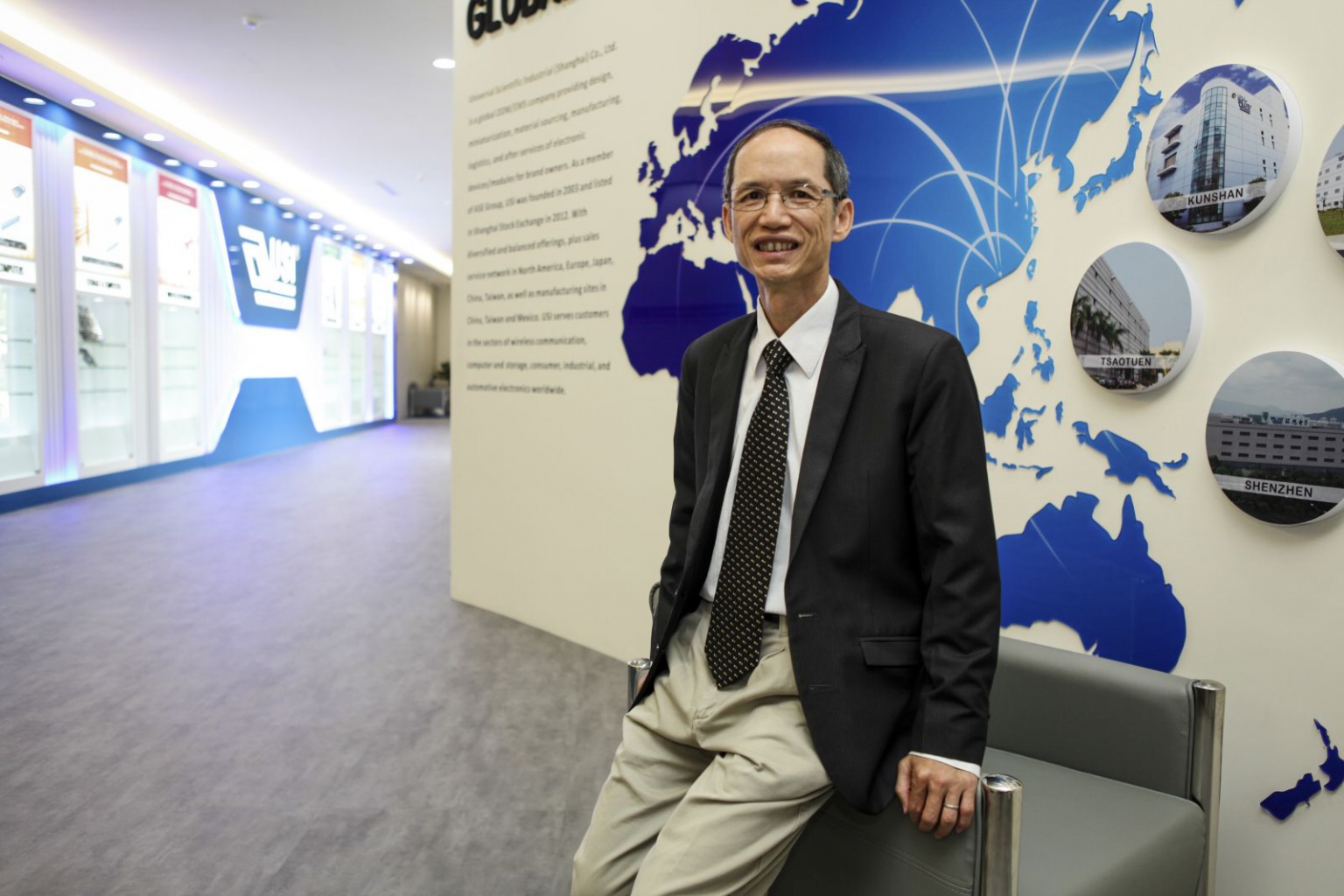- Media Highlights
- 05/23/2017
USI: Expanding the SiP/SiM Market with the Unique D(MS)2 Operating Model (DIGITIMES)
USI President, Mr. CY Wei
(DIGITIMES 05/23/2017) Under the two trendy development of semiconductor manufacturing process shortening and the miniaturizing of electronic products, the SiP (system in package) has become the recent major focus of industrial development. Universal Scientific Industrial (Shanghai) Co., Ltd. (USI), a subsidiary corporation of the ASE Group and formerly known as the Universal Scientific Industrial Co., Ltd., has integrated the group's resources to expand the SiP/SiM market successfully and resulted in a brilliant business performance. Its net profit has increased greatly last year and the first quarter of this year.
Unlike the SiP market that OSAT (Outsourced Semiconductor Assembly and Test) manufacturers target, USI has exploited another path by demonstrating its existing ODM/EMS operating model and product technological capability, which not only created the one and only D(MS)2 operating model, but also established a technological advantage rich with differentiation. General Manager CY Wei of USI elaborated on his thoughts on the development of SiP/SiM market and the development strategy of USI in detail when accepting our interview.
High Technological Barrier the D(MS)2 Operation Model is One-of-a-Kind
CY Wei explained that, "USI originally specialized in using a high-density SMT to design and manufacture miniaturized modules and systematic products. After being incorporated by the ASE Group, with the group's technological support of molding, sputtering and shielding on the field of packaging, USI is able to further integrate them and develops a much smaller miniaturized system module of SiP/SiM with higher component density."
The SiP/SiM module developed by USI is different from the SiP market targeted by OSAT manufacturers. Their major difference is that, the SiP of OSAT manufacturers still start off from IC and component-level packaging, providing pure outsourcing services without materials, and does not involve the field of system application and product development.
On the other hand, the existing ODM/EMS operating model of the USI provides product and module design with materials and has accumulated years of abundant product designing capability. Therefore, USI can start off from system designing and develop miniaturized system modules. CY Wei referred to this special operation model as D(MS)2, which is the combination of DMS with "miniaturization" (M) and "solution" (S). By developing miniaturized technological solutions, it allows the corporation to provide services with higher added value and exploit new patterns in the current supply chain.
He stressed that, "Looking at the present OSAT and CM/DMS industry as a whole, only a handful of manufacturers are capable of conducting system design and have miniaturized technology capability simultaneously. USI has occupied an extremely advantageous spot, because there lay the difficulties for present OSAT or CM/DMS manufacturers to enter the SiP/SiM market, which is the specialty of USI."
First of all, for OSAT manufacturers, their strengths are mainly versatile packaging technologies such as reballing and bonding, and will develop into more advanced technologies as the manufacturing process shortens. However, they lack systematic and applicable product planning and designing capabilities. As for the molding of SiP/SiM products, they might include dozens or even hundreds of components of different pitches and heights, which result in highly complicated mold-flow uniformity control and manufacturing process requirements. Therefore, the IC experience is simply not enough and it requires the re-establishment of designing regulations. USI has accumulated years of abundant experiences in this field and has the technological advantage. On the other hand, although CM/DMS manufacturers are skilled at product designing, they are only equipped with traditional SMT technology regarding manufacturing and it is more difficult for them to cross the threshold to achieve high density SMT and packaging technologies.
As for market competition, CY Wei stated that currently there are two major competitors: one is SEMCO, which is a subsidiary corporation of Samsung, and the other is the Japanese manufacturer of Murata. However, the SiP/SiM manufacturing of SEMCO mainly used for their own products, so the only real competitor that USI will often encounter is the Japanese manufacturer of Murata. On the other hand, although Murata, which is a major passive component manufacturer, is conducting the operation of miniaturized modules through acquisition, it is unable to provide as many versatile product combinations as USI in this field besides Wi-Fi modules.
Therefore, we can discover that, by combining the resources of ASE Group, USI has evidently created a brand new boundary in the market. It is being favored by leading and large consumer electric manufacturers and has demonstrated powerful development dynamism.
Estimates on the Potential Business Opportunities of SiP/SiM Market
Given that the miniaturization of semiconductors is hitting a bottleneck and the desperate demand on the miniaturization of mobile and wearable devices that can install more functions in smaller devices, the packaging technology of SiP was thus developed. CY Wei believes that as the semiconductor industry is entering a generation of transcending "More than Moore", SiP/SiM will definitely enjoy long-term demand and optimistic development prospects.
Given that this is a newly emerging field, there is currently no comprehensive market research data. However, when analyzed from the overall perspective of the electronic industry, CY Wei pointed out that SiP/SiM is a newly emergent market segmentation between PCBA (Printed Circuit Board Assembly) and OSAT. The scale of a reasonable total available market (TAM) and serviceable available market (SAM) should be around US$100 billion and US$70 billion.
Although these figures look larger than the present scale of OSAT, the operating model of SiP/SiM differs from OSAT due to the fact that it is a service with the materials. If we take off the material costs, which is 70% of the total revenues, then the output value of its manufacturing value added (MVA) is around US$20 to 30 billion, which is relevant to the scale of OSAT.
Analyzing it from the gross margin of the electronic industry value chain, the gross margin of PCBA/EMS and OSAT is 5% to 15% and 20% to 30%, respectively. Therefore, the reasonable gross margin of the newly emergent market of SiP/SiM should be between 10% and 20%.
If we observe the announced CM/DMS manufacturers ranking of 2015, we can discover that although USI, which ranks number 15, has revenues of around US$4 billion, its scale is much smaller than other leading manufacturers. However, due to the fact that USI has better technological capability, it enjoys a better gross margin and profit margin than the top ten CM/DMS manufacturers.
CY Wei further stressed that, "This is the reason why USI is aggressively transforming itself to the new operation model of D(MS)2. Besides being able to enjoy better profits, it also opens up a new battlefield, creates a new field that USI stands on top alone and rids itself from the red sea market that conducts price competition."
He compared the market occupancy of the leading manufacturers on the industries of CM/DMS, OSAT and foundry. Foxconn and AGE Group both enjoy the market leadership of around 20% to 30% while TSMC takes up more than 50% of the market share, which is an extraordinary case.
Therefore, if the SAM of SiP/SiM is US$70 billion, and USI can be the leading manufacturer in this market segment with the market occupancy of 15% to 25%, then its revenues will reach US$10 to 20 billion. Compared to the currently revenues of around US$4 billion, there is plenty of room for development and is the goal that USI is working hard on when facing the future.
Market Growth can be Expected There are still Challenges to Overcome
Although it has optimistic long-term development potentials, CY Wei admitted given that this is an emerging market with a high technological threshold and only a handful of manufacturers are investing that there are still some challenges to resolve regarding costs and design lead time.
He explained, "Given that this is a new technology, we cannot reduce current costs by reducing the usage of materials. It will take a while to wait for more customers willing to adopt this technology. Only when we reach economies of scale, can the costs be reduced and bring about skyrocketing growth to this market."
Also, the design duration of IC is usually longer than PCB. However, when developing the SiP/SiM, designers have to wait until the latest IC is complete before conducting development and cannot just package the ICs like PCBs. In addition to this, within one SiP/SiM requires the chip integration of various manufacturers, thus making such integration more difficult. Therefore, current the SiP/SiM is yet to fulfill the “lead time” demand of the market.
In order to resolve this issue, CY Wei pointed out that, we can discover in recent years, that there was intensive merging in the semiconductor industry and many of them have the strategic mindset of establishing a comprehensive product combination to rapidly introduce systematic product development. In the future, we have to strengthen our cooperation with semiconductor manufacturers to shorten the duration through simultaneous development. The initiative integration and settlement done by major indicative systematic brand manufacturers is also another way to resolve this issue. However, he takes these issues optimistically and believes that they will be solved as the development of this industry progress, just like EMS and foundry were doubted and challenged in their early days when they just emerged. It takes time for new models to be accepted.
As for the role USI can play, it is currently pondering on the developmental direction of ASSSiP (Application Specific Standard SiP). It attempts to shorten the lead time by developing standard SiP products for specific applications. For example, mobile devices such as notebook PCs and tablet PCs want to minimize the size of their motherboard to make room for larger batteries in order to extend their battery life. If certain functional blocks can be provided through by means of SiP/SiM, it can evidently reduce the size of mother boards and achieve the aforementioned goal. This is where the product efficacy of USI can be demonstrated.
Therefore, CY Wei stressed that, "We will further improve our software and problem-solving capability. We want to develop miniaturized system module products according to the ultimate using scenarios and not just meeting the technological specifications. We demand from ourselves an understanding of the needs of the market and even understand the trends of application better than our customers. This is where our value exists. "
In the end, USI will focus on the product category of 4C+I (Computer, Communication, Consumer, Car and Industry). With its flexible business model and its unique capability and leading advantage on miniaturization and problem-solving solutions, USI will fully be involved in the growing SiP/SiM market and bring about new development opportunities for the corporation.



